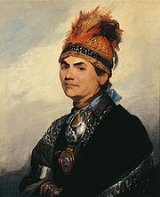
Native Americans in the United States
Overview
Native Americans in the United States are the indigenous peoples
in North America
within the boundaries of the present-day continental United States
, parts of Alaska
, and the island state of Hawaii
. They are composed of numerous, distinct tribes
, states
, and ethnic group
s, many of which survive as intact political communities. The terms used to refer to Native Americans have been controversial
. According to a 1995 US Census Bureau set of home interviews, most of the respondents with an expressed preference refer to themselves as American Indians or Indians, and this term has been adopted by major newspapers and some academic groups.
Since the end of the 15th century, the migration
of Europeans to the Americas, and their importation of Africans as slaves, has led to centuries of conflict and adjustment between Old
and New World
societies.
Indigenous peoples of the Americas
The indigenous peoples of the Americas are the pre-Columbian inhabitants of North and South America, their descendants and other ethnic groups who are identified with those peoples. Indigenous peoples are known in Canada as Aboriginal peoples, and in the United States as Native Americans...
in North America
North America
North America is a continent wholly within the Northern Hemisphere and almost wholly within the Western Hemisphere. It is also considered a northern subcontinent of the Americas...
within the boundaries of the present-day continental United States
United States
The United States of America is a federal constitutional republic comprising fifty states and a federal district...
, parts of Alaska
Alaska
Alaska is the largest state in the United States by area. It is situated in the northwest extremity of the North American continent, with Canada to the east, the Arctic Ocean to the north, and the Pacific Ocean to the west and south, with Russia further west across the Bering Strait...
, and the island state of Hawaii
Hawaii
Hawaii is the newest of the 50 U.S. states , and is the only U.S. state made up entirely of islands. It is the northernmost island group in Polynesia, occupying most of an archipelago in the central Pacific Ocean, southwest of the continental United States, southeast of Japan, and northeast of...
. They are composed of numerous, distinct tribes
Indian tribe
In the United States, a Native American tribe is any extant or historical tribe, band, nation, or other group or community of Indigenous peoples in the United States...
, states
Sovereign state
A sovereign state, or simply, state, is a state with a defined territory on which it exercises internal and external sovereignty, a permanent population, a government, and the capacity to enter into relations with other sovereign states. It is also normally understood to be a state which is neither...
, and ethnic group
Ethnic group
An ethnic group is a group of people whose members identify with each other, through a common heritage, often consisting of a common language, a common culture and/or an ideology that stresses common ancestry or endogamy...
s, many of which survive as intact political communities. The terms used to refer to Native Americans have been controversial
Native American name controversy
The Native American name controversy is a dispute about the acceptable terminology for the indigenous peoples of the Americas and broad subsets of these peoples, such as those sharing certain cultures and languages by which more discrete groups identify themselves .Many English exonyms have been...
. According to a 1995 US Census Bureau set of home interviews, most of the respondents with an expressed preference refer to themselves as American Indians or Indians, and this term has been adopted by major newspapers and some academic groups.
Since the end of the 15th century, the migration
Human migration
Human migration is physical movement by humans from one area to another, sometimes over long distances or in large groups. Historically this movement was nomadic, often causing significant conflict with the indigenous population and their displacement or cultural assimilation. Only a few nomadic...
of Europeans to the Americas, and their importation of Africans as slaves, has led to centuries of conflict and adjustment between Old
Old World
The Old World consists of those parts of the world known to classical antiquity and the European Middle Ages. It is used in the context of, and contrast with, the "New World" ....
and New World
New World
The New World is one of the names used for the Western Hemisphere, specifically America and sometimes Oceania . The term originated in the late 15th century, when America had been recently discovered by European explorers, expanding the geographical horizon of the people of the European middle...
societies.
Unanswered Questions

